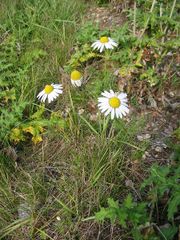Tripleurospermum maritimum subsp. inodorum
| Tripleurospermum maritimum subsp. inodorum var. | ||||||||||||||||||||||||||||||||||||||||||||||||||||||||
|---|---|---|---|---|---|---|---|---|---|---|---|---|---|---|---|---|---|---|---|---|---|---|---|---|---|---|---|---|---|---|---|---|---|---|---|---|---|---|---|---|---|---|---|---|---|---|---|---|---|---|---|---|---|---|---|---|

|
|
| ||||||||||||||||||||||||||||||||||||||||||||||||||||||
| ||||||||||||||||||||||||||||||||||||||||||||||||||||||||
Matricaria perforata is a species of Mayweed.
The taxonomy of the genus Matricaria has been the subject of some controversy, with many revisions in recent years. The Flora Europaea uses Matricaria perforata for this species. Synonyms/other scientific names include Tripleurospermum perforatum (Mérat) Lainz, Tripleurospermum maritimum subsp. inodorum, Tripleurospermum inodorum.
Common name(s): scentless mayweed, scentless chamomile, wild chamomile, mayweed, false chamomile, German chamomile, Baldr's Brow
Origin Eurasia, North Africa
Considered an invasive weed in North America
| Standard Cyclopedia of Horticulture |
|---|
|
Matricaria chamomilla, Linn. (Chamomilla officinalis, Koch). Wild Chamomile. Glabrous erect much- branched annual: lvs. 2-3-pinnate, with segms. short and very narrow-linear, giving the lf. a finely dissected appearance: heads rather large (nearly 1 in. across), on terminal peduncles, with 10-20 truncate white rays; bracts of involucre of about equal length, the edges scarious; receptacle without scales, elongating and hollow as anthesis advances: achene with 3-5 faint ribs and no border at top. Fields, Eu. and N. Asia; run wild in E. U. S.—Very similar in appearance to Anthemis Cotula, but lacks the scales between the central florets and has a different odor. The name chamomile, or sometimes spelled camomile, is applied both in Matricaria and Anthemis.
|
| Standard Cyclopedia of Horticulture |
|---|
|
Matricaria inodora, Linn. (Chrysanthemum inodorum, Linn. Pyrethrum inodorum, Smith). Nearly or quite glabrous, branchy, diffuse annual, 1-2 ft. tall, from Eu. and Asia: lvs. many, sessile, 2-3-pinnately divided or dissected: heads 1½in. across, terminating the branches, with many acute white rays: achenes inversely pyramidal, with 3 conspicuous ribs. Not uncommon in fields eastward. Var. plenissima, Hort. (var. ligulosa, var. multiplex, M. grandiflora, Hort. not Fenzl), ia a common garden plant with very double clear white large heads. It is floriferous, and the fls. are fine for cutting.—It often persists and blooms the second year. Foliage little or not at all scented.
|
Cultivation
Propagation
Pests and diseases
Varieties
Gallery
-
photo 1
-
photo 2
-
photo 3
References
- Standard Cyclopedia of Horticulture, by L. H. Bailey, MacMillan Co., 1963
External links
- w:Tripleurospermum maritimum subsp. inodorum. Some of the material on this page may be from Wikipedia, under the Creative Commons license.
- Tripleurospermum maritimum subsp. inodorum QR Code (Size 50, 100, 200, 500)
